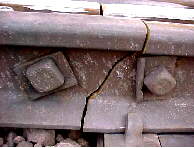Nearly 40 percent of all train derailments in the United States result from broken rails or other track problems. Looking only at train crashes that occur outside of rail yards, the percentage of derailments that happen when switches fail to close, rocky ballast subsides or railroad ties become displaced rises to almost half.

The Brotherhood of Maintenance of Way Employees Division cited those federal statistics in a March 23, 2015, call for rail corporations to dedicate more attention and resources to keeping tracks in proper repair. The union, a division of the International Brotherhood of Teamsters, further noted that preventing derailments by fixing deteriorating track beds and warping rails has recently taken on extra urgency because increasing amounts of highly flammable crude oil is being shipped across the country by train.
According to BMWED President Freddie N. Simpson:
Main line tracks crisscross the nation passing through thousands of cities, towns, and communities where we live. The key to reducing track-caused derailments is maintaining the tracks to a higher safety standard. Unfortunately, the railroads’ own statistics speak for themselves and track caused derailments–including those involving highly volatile crude oil–continue to be a threat to the nation. We can significantly improve railroad safety by improving the quality of the track. The technology, the skilled workers, and the higher track standards already exist; this is not rocket science.
This alert is just know drawing attention in relation to the release on May 1, 2015, of updated U.S. and Canadian regulations for the design and operation of railroad tank cars used for transporting petroleum, ethanol and other flammable liquids. The full details are available on the federal Department of Transportation website.
Freight rail corporations’ response to the new rules have been less than reassuring. While claiming that its members have already begun replacing the entire stock of old tank cars, the Association of American Railroads cited budget concerns and “unproven technology” as reasons to resist installing improved braking systems on tank cars. Rather than promise to comply with a longstanding request to deploy system know generally as positive train control, or PTC, the AAR insists government regulators have “no substantial evidence to support a safety justification for mandating” it.
The USDOT and several of its agencies have repeatedly delayed rules requiring PTC. Now that safety officials believe they can no longer wait to ensure the public’s safety by demanding the rollout of a specific system called electronically controlled pneumatic brakes, rail corporations continue pushing back. CSX echoed its industry group, telling a television station, ““We are deeply troubled by the requirement for electronically controlled pneumatic brakes, a braking technology that is still in development and not proven in regular service.”
Virginia, where my personal injury and wrongful death law firm colleagues and I focus on helping railroad workers hurt on the job, has narrowly escaped at least two major CSX oil train derailments without suffering loss of life. The environmental and property damage from each potentially preventable accident has been extensive, however. We know that the shipment of flammable liquids by rail needs to be made safer. Companies that fight efforts to do so by neglecting track maintenance and refusing to adopt well-tested automatic braking technologies place everyone at risk.
EJL





